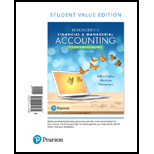
1.
No significant influence equity investments:
These investments are the investments in equity securities where the investor holds less than 20% of the voting stock, and thereby the investor would not be able to participate in the decisions of the investee company. These investments are reported as the current assets or the long-term assets on the basis of the period which the investor holds the investments.
Trading Debt Investments:
Trading debt investments are the investments in debt securities where the investors wish to sell these investments at a short notice like in a few days, week, or months to generate some profit out of it. They are treated as current assets.
To classify: Each of the investments made by Corporation CT during the year 2018.
2.
To journalize: The transactions for the investments of Corporation CT for the year 2018.
3.
To prepare: T-accounts for the investment assets, and to show how to report the investments on Corporation CT’s balance sheet at December 31, 2018.
4.
To indicate: The statement in which the unrealized holding gain or loss associated with the trading debt investment is reported.
Want to see the full answer?
Check out a sample textbook solution
Chapter 10 Solutions
Horngren's Financial & Managerial Accounting, The Managerial Chapters, Student Value Edition (6th Edition)
- I need help with general accountingarrow_forwardWhat is the budgeted cost of goods sold for March?arrow_forwardIf the cost of the beginning work in process inventory is $78,500, cost of goods manufactured is $1,050,000, direct materials cost is $340,000, direct labor cost is $265,000, and overhead cost is $410,000, calculate the ending work in process inventory.arrow_forward
- General accounting question and right solutionarrow_forwardJamal Company has liabilities equal to one-third of the total assets. Jamal's stockholders' equity is $80,000. Using the accounting equation, what is the amount of liabilities for Jamal?arrow_forwardDirect labour cost variance: Valora Furnishings sets a standard material cost of $6.60 per chair, based on 5 square feet of fabric at a cost of $1.32 per square foot. In February, a production run of 1,200 chairs resulted in the usage of 6,500 square feet of fabric at a cost of $1.10 per square foot, totaling $7,150. What is the quantity variance resulting from the above production run?arrow_forward

 AccountingAccountingISBN:9781337272094Author:WARREN, Carl S., Reeve, James M., Duchac, Jonathan E.Publisher:Cengage Learning,
AccountingAccountingISBN:9781337272094Author:WARREN, Carl S., Reeve, James M., Duchac, Jonathan E.Publisher:Cengage Learning, Accounting Information SystemsAccountingISBN:9781337619202Author:Hall, James A.Publisher:Cengage Learning,
Accounting Information SystemsAccountingISBN:9781337619202Author:Hall, James A.Publisher:Cengage Learning, Horngren's Cost Accounting: A Managerial Emphasis...AccountingISBN:9780134475585Author:Srikant M. Datar, Madhav V. RajanPublisher:PEARSON
Horngren's Cost Accounting: A Managerial Emphasis...AccountingISBN:9780134475585Author:Srikant M. Datar, Madhav V. RajanPublisher:PEARSON Intermediate AccountingAccountingISBN:9781259722660Author:J. David Spiceland, Mark W. Nelson, Wayne M ThomasPublisher:McGraw-Hill Education
Intermediate AccountingAccountingISBN:9781259722660Author:J. David Spiceland, Mark W. Nelson, Wayne M ThomasPublisher:McGraw-Hill Education Financial and Managerial AccountingAccountingISBN:9781259726705Author:John J Wild, Ken W. Shaw, Barbara Chiappetta Fundamental Accounting PrinciplesPublisher:McGraw-Hill Education
Financial and Managerial AccountingAccountingISBN:9781259726705Author:John J Wild, Ken W. Shaw, Barbara Chiappetta Fundamental Accounting PrinciplesPublisher:McGraw-Hill Education





